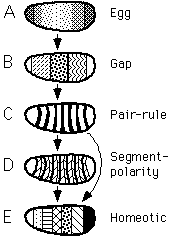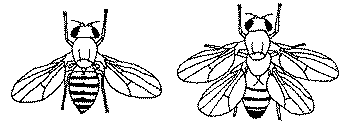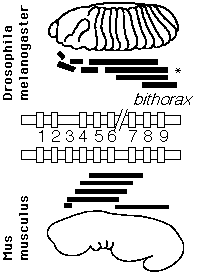Press release

NOBELFÖRSAMLINGEN KAROLINSKA INSTITUTET
THE NOBEL ASSEMBLY AT THE KAROLINSKA INSTITUTE
9 October 1995
The Nobel Assembly at the Karolinska Institute has today decided to award the Nobel Prize in Physiology or Medicine for 1995 jointly to
Edward B. Lewis, Christiane Nüsslein-Volhard and Eric F. Wieschaus
for their discoveries concerning “the genetic control of early embryonic development”.
Summary
The 1995 laureates in physiology or medicine are developmental biologists who have discovered important genetic mechanisms which control early embryonic development. They have used the fruit fly, Drosophila melanogaster, as their experimental system. This organism is classical in genetics. The principles found in the fruit fly, apply also to higher organisms including man.
Using Drosophila Nüsslein-Volhard and Wieschaus were able to identify and classify a small number of genes that are of key importance in determining the body plan and the formation of body segments. Lewis investigated how genes could control the further development of individual body segments into specialized organs. He found that the genes were arranged in the same order on the chromosomes as the body segments they controlled. The first genes in a complex of developmental genes controlled the head region, genes in the middle controlled abdominal segments while the last genes controlled the posterior (“tail”) region. Together these three scientists have achieved a breakthrough that will help explain congenital malformations in man.
The fertilized egg is spherical. It divides rapidly to form 2, 4 , 8 cells and so on. Up until the 16-cell stage the early embryo is symmetrical and all cells are equal. Beyond this point, cells begin to specialize and the embryo becomes asymmetrical. Within a week it becomes clear what will form the head and tail regions and what will become the ventral and dorsal sides of the embryo. Somewhat later in development the body of the embryo forms segments and the position of the vertebral column is fixed. The individual segments undergo different development, depending on their position along the “head-tail” axis. Which genes control these events? How many are they? Do they cooperate or do they exert their controlling influence independently of each other?
This year’s laureates have answered several of these questions by identifying a series of important genes and how they function to control the formation of the body axis and body segments. They have also discovered genes that determine which organs that will form in individual segments. Although the fruit fly was used as an experimental system, the principles apply also to higher animals and man. Furthermore, genes analogous to those in the fruit fly have been found in man. An important conclusion is that basic genetic mechanisms controlling early development of multicellular organisms have been conserved during evolution for millions of years.
Brave decision by two young scientists
Christiane Nüsslein-Volhard and Eric Wieschaus both finished their basic scientific training at the end of the seventies. They were offered their first independent research positions at the European Molecular Biology Laboratory (EMBL) in Heidelberg. They knew each other before they arrived in Heidelberg because of their common interest: they both wanted to find out how the newly fertilized Drosophila egg developed into a segmented embryo. The reason they chose the fruit fly is that embryonic development is very fast. Within 9 days from fertilization the egg develops into an embryo, then a larvae and then into a complete fly.
 |
Fig. 1. Regions of activity in the embryo for the genes belonging to the gap, pair-rule, and segment-polarity groups. The gap genes start to act in the very early embryo (A) to specify an initial segmentation (B). The pair-rule genes specify the 14 final segments (C) of the embryo under the influence of the gap genes. These segments later acquire a head-to-tail polarity due to the segment polarity genes.
They decided to join forces to identify the genes which control the early phase of this process. It was a brave decision by two young scientists at the beginning of their scientific careers. Nobody before had done anything similar and the chances of success were very uncertain. For one, the number of genes involved might be very great. But they got started. Their experimental strategy was unique and well planned. They treated flies with mutagenic substances so as to damage (mutate) approximately half of the Drosophila genes at random (saturation mutagenesis). They then studied genes which, if mutated would cause disturbances in the formation of a body axis or in the segmentation pattern. Using a microscope where two persons could simultaneously examine the same embryo they analyzed and classified a large number of malformations caused by mutations in genes controlling early embryonic development. For more than a year the two scientists sat opposite each other examining Drosophila embryos resulting from genetic crosses of mutant Drosophila strains. They were able to identify 15 different genes which, if mutated, would cause defects in segmentation. The genes could be classified with respect to the order in which they were important during development and how mutations affected segmentation. Gap genes (Fig 1) control the body plan along the head-tail axis. Loss of gap gene function results in a reduced number of body segments. Pair rule genes affect every second body segment: loss of a gene known as “even-skipped” results in an embryo consisting only of odd numbered segments. A third class of genes called segment polarity genes affect the head-to-tail polarity of individual segments.
The results of Nüsslein-Volhard and Wieschaus were first published in the English scientific journal Nature during the fall of 1980. They received a lot of attention among developmental biologists and for several reasons. The strategy used by the two young scientists was novel. It established that genes controlling development could be systematically identified. The number of genes involved was limited and they could be classified into specific functional groups. This encouraged a number of other scientists to look for developmental genes in other species. In a fairly short time it was possible to show that similar or identical genes existed also in higher organisms and in man. It has also been demonstrated that they perform similar functions during development.
The fly with the extra pair of wings
Already at the beginning of this century geneticists had noted occasional malformations in Drosophila. In one type of mutation the organ that controls balance (the halteres), was transformed into an extra pair of wings (Fig. 2). In this type of bizarre disturbance of the body plan, cells in one region behave as though they were located in another. The Greek word homeosis was used to describe this type of malformations and the mutations were referred to as homeotic mutations.

Fig. 2. Comparison of a normal and a four-winged fruit fly. The third thoractic segment has developed as a duplicate of the second due to a defectic homeotic gene. In the normal fly only the second segment develops wings.
The fly with the extra pair of wings interested Edward B. Lewis at the California Institute of Technology in Los Angeles. He had, since the beginning of the forties, been trying to analyze the genetic basis for homeotic transformations. Lewis found that the extra pair of wings was due to a duplication of an entire body segment. The mutated genes responsible for this phenomenon were found to be members of a gene family ( bithorax-complex) that controls segmentation along the anterior-posterior body axis (Fig. 3). Genes at the beginning of the complex controlled anterior body segments while genes further down the genetic map controlled more posterior body segments (the colinearity principle). Furthermore, he found that the regions controlled by the individual genes overlapped, and that several genes interacted in a complex manner to specify the development of individual body segments. The fly with the four wings was due to inactivity of the first gene of the bithorax complex in a segment that normally would have produced the halteres, the balancing organ of the fly (Fig 3). This caused other homeotic genes to respecify this particular segment into one that forms wings.
Edward Lewis worked on these problems for decades and was far ahead of his time. In 1978 he summarized his results in a review article and formulated theories about how homeotic genes interact, how the gene order corresponded to the segment order along the body axis, and how the individual genes were expressed. His pioneering work on homeotic genes induced other scientists to examine families of analogous genes in higher organisms. In mammalians, the gene clusters first found in Drosophila have been duplicated into four complexes known as the HOX genes. Human genes in these complexes are sufficiently similar to their Drosophila analogues they can restore some of the normal functions of mutant Drosophila genes.
 |
Fig. 3. The principle of colinearity in Drosophila (A-C) and mouse (Mus musculus, D-F) embryos. The horizontal bars indicate in which areas the homeotic genes 1-9 are active along the body axis. Gene 1 is active in the head region (left in A and F, respectively); gene 9 is active in the tail region (right). Gene 7 of the bithorax complex was inactive in the fly with four wings. The bar showing its normal range of activity is indicated with an asterisk.
The individual genes within the four HOX gene families in vertebrates occur in the same order as they do in Drosophila , and they exert their influence along the body axis (Fig 3 D-F) in agreement with the colinearity principle first discovered by Lewis in Drosophila. More recent research has suggested that the segments where shoulders and the pelvis form is determined by homeotic genes.
Congenital malformations in man
Most of the genes studied by Nüsslein-Volhard, Wieschaus and Lewis have important functions during the early development of the human embryo. The functions include the formation of the body axis, i.e. the polarity of the embryo, the segmentation of the body, and the specialization of individual segments into different organs. It is likely that mutations in such important genes are responsible for some of the early, spontaneous abortions that occur in man, and for some of the about 40% of the congenital malformations that develop due to unknown reasons. Environmental factors such as very high doses of vitamin A during early pregnancy are also known to disturb the regulation of HOX-genes, thus inducing severe congenital malformations.
In some cases have mutations been found in human genes related to those described here for Drosophila. A human gene related to the Drosophila gene paired will cause a condition known as Waardenburg’s syndrome. It is a rare disease which involves deafness, defects in the facial skeleton and altered pigmentation of the iris. Another developmental gene mutation causes a complete loss of the iris, a condition known as aniridia.
| Literature |
| Lewis, E.B. (1978) A Gene Complex Controlling Segmentation in Drosophila. Nature 276, 565-570 |
| Nüsslein-Volhard, C., Wieschaus, E. (1980). Mutations Affecting Segment Number and Polarity in Drosophila. Nature 287, 795-801 |
| McGinnis, W., Kuziora, M. (1994). The Molecular Architects of Body Design. Scientific American 270, 36-42 |
| Lawrence, P. The Making of a Fly. Blackwell Scientific Publications. Oxford 1992. |
| The Molecular Biology of the Cell. Eds Alberts, B. et al, 3rd edition pp 1077-1107. Garland Publishing, New York 1994. |
Nobel Prizes and laureates
Six prizes were awarded for achievements that have conferred the greatest benefit to humankind. The 14 laureates' work and discoveries range from quantum tunnelling to promoting democratic rights.
See them all presented here.
